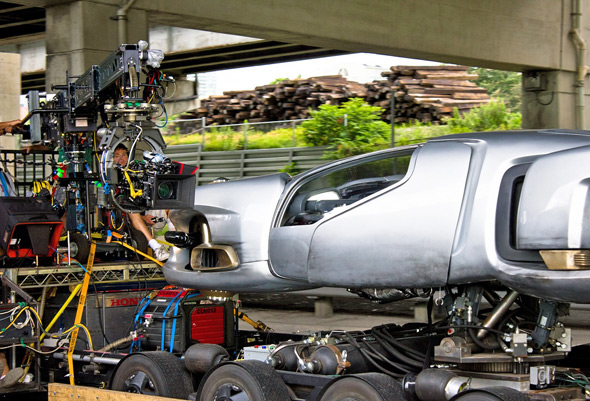via http://www.behance.net/gallery/Star-Wars-Pixel-Posters/1341269
Archive for July, 2011
Citriodora House by Seeley Architects
Seeley Architects have designed the Citriodora House in the town of Anglesea, Australia.

.


















Citriodora House by Seeley Architects
‘Citriodora’ is a holiday retreat set amongst a stand of beautiful Lemon scented gums, near Australia’s famed Great Ocean Road in Anglesea, Victoria. It is one of a number of inspired beach houses that Seeley Architects have designed over the past 10 or so years in this small coastal holiday hamlet.
The name ‘Citriodora’ is derived from the botanical name of the beautiful trees that dominate the northern corner of the property.
Inspired by the affects of the coastal winds, the form of the roof gently rolls, mimicking the shape of the wind pruned coastal vegetation. There is both simplicity and complexity in this building with large negative spaces offering views to the sky, battened screens proving visual privacy to the neighbours and two massive concrete walls forming a prehistoric spine through the middle. A thermal heat soak for the interior that mediates the diurnal temperature variations within the house.
This beautiful dwelling has been designed to maximise the opportunities offered by the site, with a character that respects its locality and environment.
The layout of the house is centred around a raised east facing living platform capturing coastal views and connections into the treetops. It is reminiscent of an adult’s tree house.
The approach to this house is a gentle rise gently from the street. It is sited in the lee of a small hill and nestled closely between two neighbouring houses.
Upon entering the house, you are greeted by massive in-situ concrete walls that form the staircase spine and dominate the entry space. This floor is the teenager’s zone with a swathe of bunks, a TV nook and a pool table for the obligatory holiday competitions.
Rising upward into the kitchen – living area, one’s eye is taken by the breathtaking views along the coastal cliffs and Southern ocean. Separated from the living zone by a protected courtyard deck and a generous internal void, lays the master bedroom, study, bathroom and a guest bedroom. The ceiling that sweeps generous over the entire upper level is gently formed from plywood and is reminiscent of the hull of an upturned yacht.
Wrapping around the exterior of the house is sustainable grown timber boards, fixed with maritime bronze nails, resisting the harsh coastal conditions and gradually weathering to a soft driftwood grey, a reference to the Citriodora tree’s bark.
This elegantly simple house uses a minimal palette with an aesthetic pared back to the essentials. It will gradually develop a patina over time, further blending with the grey-green of the site vegetation and providing a positive response to its impressive loci.
.
Visit the Seeley Architects website – here.
Photography by Zoe Economides, John Walker, and David Seeley
.
Photos of the new Total Recall being filmed in Toronto
 Although the new monster-budget remake of 1990's Total Recall has been filming in Toronto for almost two months, thus far the action has been mostly confined to the sound stage at Pinewood Studios on Commissioners Street in the Port Lands. Earlier this week, however, the production got a whole lot more public. With stars Colin Farrell and Jessica Biel in tow, film crews descended on Lake Shore Avenue East to shoot one of what will likely be a number of chase scenes in the $200 million movie, the most expensive to be shot in Toronto to date.
Although the new monster-budget remake of 1990's Total Recall has been filming in Toronto for almost two months, thus far the action has been mostly confined to the sound stage at Pinewood Studios on Commissioners Street in the Port Lands. Earlier this week, however, the production got a whole lot more public. With stars Colin Farrell and Jessica Biel in tow, film crews descended on Lake Shore Avenue East to shoot one of what will likely be a number of chase scenes in the $200 million movie, the most expensive to be shot in Toronto to date.
I'm not one to gawk at celebrities, but I've always been fascinated by behind-the-scenes shots of film productions, particularly those which promise to feature gratuitous special effects. While I have little difficulty suspending disbelief in the theatre, it remains intriguing to see what the filmmakers and editors have to work with, even if it's invariably less exciting than the final product.
The stretch of Lake Shore where the filming took place is back open today, but one suspects this isn't the last time that the Total Recall cast and crew make an appearance outside the studio. Check out the photos below, and if you have shots of the production, send them to the blogTO Flickr pool. Lead shot by syfractal.
 Photo by dtstuff9
Photo by dtstuff9
 Photo by Max Quijano
Photo by Max Quijano
Plutonium Is Hot Suspect in Pioneer Spacecraft Mystery
By Duncan Geere, Wired UK
A 30-year mystery as to why the Pioneer spacecraft have slowly been drifting off course is close to being explained — the latest analysis pins the blame on heat.
The Pioneer 10 and 11 spacecraft, launched in 1972 and 1973 respectively, were designed to fly past the asteroid belt and investigate the Jovian and Saturnian systems. Both are now located in the interstellar medium, and radio contact has been lost, but each is slowing gradually due to the influence of the sun’s gravity.
In 1980, an algorithm to study gravitational effects in the outer solar system was concocted by astronomer John Anderson, but it didn’t quite work. There was a discrepancy — small but noticeable — between the readings predicted by the algorithm and those actually observed from the Pioneer spacecrafts’ radio signal. The phenomenon was named the Pioneer Anomaly.
Physicists struggled to explain the discrepancy, proposing complex theories that even included a suggestion that gravity might behave differently at large distances from the Earth. However, the most recent analysis suggests a rather more mundane explanation — heat from the plutonium inside the spacecrafts’ generators.
If heat is radiating evenly in all directions from the spacecraft, then there will be no effect on its course, but if there’s a difference of as little as five percent between the front and the back then that could explain the difference between the predicted course and the course that’s actually been observed. The smoking gun is that the level of deceleration seems to be decreasing at an exponential rate, which tallies with the radioactive decay of the plutonium-238 that powers the two spacecraft.
It’s not completely out of the question that there might be another culprit, but it’s looking increasingly unlikely. NASA is performing its own investigation to compare to the data, but if that comes out with heat as the cause too, then the 30-year mystery may finally be over.
Image: NASA
Source: Wired.co.uk
Via: Discovery News
See Also:
- Space Probe Gets Halfway to Pluto in Record Time
- Reactor Drawings Make Nuclear History Beautiful
- Giant Crater Is Next Mars Rover Landing Site
- Understanding Japan’s Nuclear Crisis
- Neutrino Transformation Could Help Explain Mystery of Matter
- Chemists Inch Closer to Stable Superheavy Atoms
The Vizosphere
There are lots of people on Twitter who talk visualization. Moritz Stefaner had some fun with Gephi for a view of a whole lot of those people. He calls it the Vizosphere.
This map shows 1645 twitter accounts related to the topic of information visualization. The accounts were determined as follows: For a subjective selection of "seed accounts", the twitter API was queried for followers and friends. In order to be included into the map, a user account needed to have at least 5 links (i.e. follow or being followed) to one of these a
ccounts. The size of the network nodes indicates the number of followers within this network.
Check out the high-res version in the player below.
Cross-Species Gadget Tests Reveal Reason for Dolphin Tools
The dolphins of Australia’s Shark Bay, famed as Earth’s first marine tool-users, likely turned to gadgetry because echolocation couldn’t find the best fish, especially for hurried moms without time to hunt.
It was in 1984 that researchers first observed the dolphins fitting basket sponges over their beaks, then scraping through seafloor mud to disturb hidden fish. Research subsequently showed this behavior to be full-blown tool use, taught by mothers to their daughters and representing a profound difference in lifestyle between them and Shark Bay’s other bottlenoses.
A basic question remained unanswered, however: Though sponges clearly protected sensitive dolphin snouts from jagged pieces of rock and coral, why scrape seafloor at all? Why not rely on echolocation to pinpoint target prey?
In a study published July 20 in Public Library of Science ONE, biologists Eric Patterson and Janet Mann of Georgetown University set out to answer this question by mounting basket sponges on sticks and pushing them through Shark Bay seafloors, just as dolphins do.
Most fish scared from the muck were bottom-dwellers lacking swim bladders, the air-filled organs that help fish control their buoyancy. Compared to fish flesh, which interferes with acoustic signals just slightly more than water, air bladders stand out on sonar. Without them, bottom-dwelling fish are nearly invisible to echolocation. Hence the value of scraping through seafloors manually, and thus the need for a device that protects dolphin noses from scraping.
Hunting with sponges has allowed Shark Bay’s bottlenoses to fill an empty ecological niche, eating fish that other dolphins ignore, wrote Patterson and Mann. The findings also suggest why sponge foraging likely arose among Shark Bay’s females and has remained their province, taught by dolphin mothers to daughters rather than sons.
Whereas dolphin fathers are mostly absent, free to roam and chase prey in the open ocean, dolphin moms spend years with their calves. They need to put food on the figurative table but have little time to do it. Sponge foraging is convenient and nutritious, a family recipe for quick-but-delicious dinners passed on to daughters who will someday need it.
Image: Eric Patterson/PLoS ONE
See Also:
- To Talk With Aliens, Learn to Speak With Dolphins
- Chimps and Dolphins Share Cultural Similarities
- Whales Might Be as Much Like People as Apes Are
- Clever Critters: 8 Best Non-Human Tool Users
- Monkeys Are Gadget Junkies, Too
- Female Chimpanzees Drive the Culture
Citation: “The Ecological Conditions That Favor Tool Use and Innovation in Wild Bottlenose Dolphins (Tursiops sp.). By Eric Patterson & Janet Mann. PLoS ONE, July 20, 2011.
Black Hole Holds Universe’s Biggest Water Supply
By Mark Brown, Wired UK
Two teams of astronomers have discovered the largest and farthest reservoir of water ever found in the universe. It’s 12 billion light years away, and holds at least 140 trillion times the amount of water in all the Earth’s oceans combined.
It manifests itself as a colossal mass of water vapor, hidden in the distant APM 08279+5255 quasar. Quasars are bright and violent galactic nuclei fueled by a supermassive black hole at their center.This quasar holds a black hole that’s 20 billion times more massive than the sun, and after gobbling down dust and gas it belches out as much energy as a thousand trillion suns. The water vapor is spread around the black hole in a gaseous region spanning hundreds of light years.
“It’s another demonstration that water is pervasive throughout the universe, even at the very earliest times,†adds Bradford in the release. As the light from this watery quasar took 12 billion years to reach Earth, the observations come from a time when the universe was only 1.6 billion years old.
The water reservoir was discovered by astronomers, led by scientists at the California Institute of Technology, and using the Z-Spec instrument at the Caltech Submillimeter Observatory in Hawaii and the Combined Array for Research in Millimeter-Wave Astronomy (CARMA) in the Inyo Mountains of Southern California.
Both instruments observe in the millimeter and submillimeter wavelengths, which lie between infrared and microwave wavelengths. Over the last two to three decades, this technique has allowed astronomers to find trace gases, including water vapor, in the earliest universe.
Astronomers are now building a new telescope that specializes in these wavelengths. The proposed 25-meter telescope is called CCAT (Cornell Caltech Atacama Telescope) and would be plopped on the Cerro Chajnantor lava dome, more than 5,600 meters above sea level.
By measuring the presence of water and other important trace gases, it would allow cosmic researchers to hunt out primordial galaxies and more accurately study their composition. CCAT should start construction in 2013 and be completed in 2017.
Image: ESA/V. Beckmann (NASA-GSFC)
Source: Wired.co.uk
See Also:
- Soggy Universe: Astronomers Find Most Distant Water Yet
- Saturn’s Most Habitable Moon Offers Ice, Water, Killer Views
- Spacecraft Flies Through Cosmic Snowstorm
- Hot Water Around Giant Carbon Star Creates Interstellar Mystery
- Saturn’s Icy Moon Might Have an Ocean
- Millions of Tons of Water Ice Found at Moon’s North Pole
Photographers Capture Mysterious, Beautiful Patterns in Sand

A single sand grain is a simple thing. But en mass, grains of sand build, slide and settle into beautiful and mysterious patterns we admire, but cannot always understand.
Sand has superhero qualities, as far as geological deposits go. Behaving at times like a solid, at times a liquid and at times a gas, it is a master shape-shifter. Formed by wind and water, sand allows large-scale geography to play out in miniature: settling into ripples, channels, canyons, valleys and deltas.
Sand is born as tiny pieces break away from rock. Young grains have rough edges, which smooth with time. The roundest grains are found in the desert, where the constant shifting winds rub the grains against each other, grinding them to a smooth polish. Because of this, dunes, like those of the Sahara, move in vast waves.
For a geologist, sand is any particle of a certain size. By studying rocks that were made when sand was deposited and compacted over millions of years, geologists can learn about the conditions under which the sand was laid down. And sand can be made of anything — the Huygens probe found “sand,†made of hydrocarbon ice, when it landed on Titan — and comes in many colors.
The enormous golden dunes of the world are made mostly of silicon dioxide, in the form of quartz. Bright white sands are made of limestone or gypsum, in the case of White Sands National Monument, New Mexico. Magnetite or obsidian give sands a black color. Greenish sands hold chlorite-glauconite or olivine, also called peridot, when it is of gem-like quality. Iron-bearing sands are deep yellow, red and orange. Worn coral deposits give some beaches a pink hue.
Sand goes into nearly as many materials as it comes from: glass, bricks, concrete, paint and electronics, to name a few. It is key to the workings of our natural world and a source of endless fascination for arenophiles (sand enthusiasts).
To bring out your inner arenophile, we’ve gathered some of the strangest and most impressive pictures we could find of sand patterns.
Above:Mysterious Ridges
Martyn Gorman has found these weird and wonderful formations near his home along Scotland’s east coast on two occasions. What is at work in this magical intersection of sand and physics, no one, it seems, knows.
Image: Martyn Gorman
See Also:
- Sublime Sand: Desert Dunes Seen From Space
- Sand: The Neverending Story — Q&A with author Michael Welland
- Grains of Sand Reveal Possible Fifth State of Matter
- Dark Dust Trails Form When Whirlwinds Suck Sand Grains Clean
- Idaho’s Sand Dunes Tell Ancient Climate Story
- Video: Secrets of Swimming in Sand Revealed
Float Coffee Table by Liz Boscacci
American designer Liz Boscacci has created the Float Coffee Table.

.
Description from the designer:
Turned mahogany with glass top
3 feet diameter, 13 inches highInspired by bubbles under water floating to the surface, the objective here was to create a table with a distinctly unique base structure.


Visit Liz Boscacci’s website – here.
.
Apolo 11 House by Parra + Edwards Architects
Parra + Edwards Architects have designed the Apolo 11 House in La Reina, Santiago, Chile.

.



























Apolo 11 House by Parra + Edwards Architects
Apollo 11 is a shop house in the middle of a grove of elms at the foot of the Andes, on the outskirts of the city of Santiago. She was baptized with that name because it is designed like a ship that landed in a forest without touching it at any time and will undertake his departure, leaving the forest intact. “Apollo 11″ also for the laboratory conditions: This house functions as architecture workshop, recording studio and rehearsal room acoustic and electric music. It is a capsule that support in full the life of his crew, a family of architects and musicians.
The program is organized in two levels from a rectangular 6 x 9 mts. in 6 mts. high. The rectangle, for the Japanese is the only element that does not distort the nature, is a clean element that tends to disappear. The simplicity of the box also helps the idea of ??occupying the forest floor minimum while maximizing the heat inside the ship as it landed in a place that is very cold in winter. With two levels of heating is easy and is oriented in their bedrooms to the north with large windows that take the stored heat energy and heat through the glass. In summer the foliage of the elms control acts as natural sunlight.
The box is a simple grid structure coated metal plates on their skin for plywood of 18 mm. glass plates and allowing full and empty that resemble the dark and light fragments produced in the foliage of trees. The skeleton of this structure is always visible, with the metal profiles metaphor from the trunks and branches of this new forest and wood planes of the leaves of the tree. That’s why their facades are indefinite and change in different seasons of the year through mobile web pages are the thermal checked in and out depending on what is happening in the forest itself.
Inside the ship, the inhabitant is a guest, a silent spectator of the nature of the forest in all its dimensions, as a temporary crew capsule observation ephemeral aware of their status in a place that belongs to him, but that is not property.
.
Visit the Parra + Edwards Architects website – here.
Photography by Rodrigo Avilés
.





















